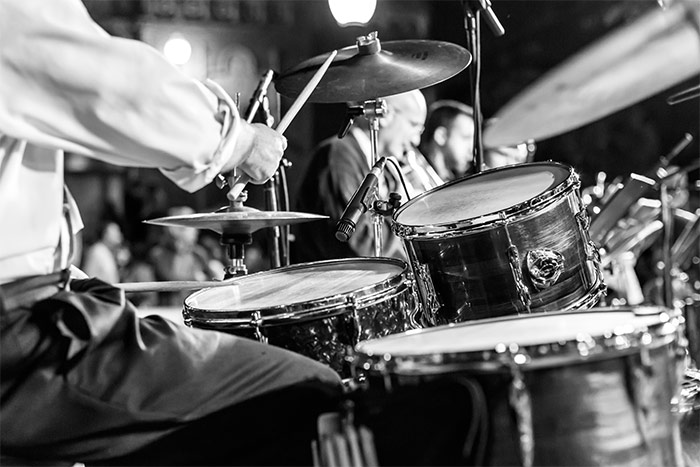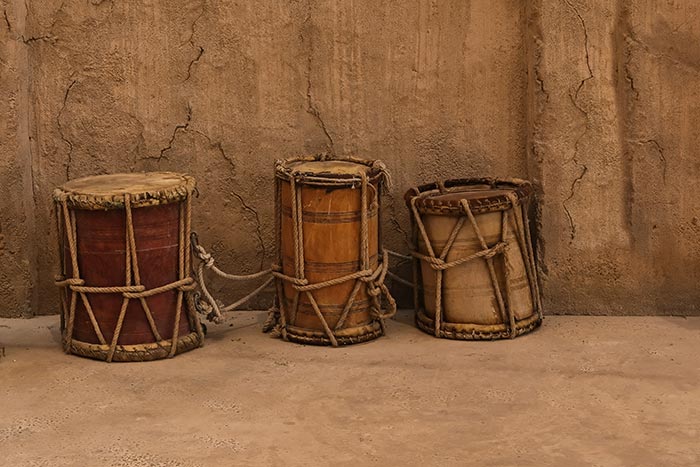Drums are among the oldest and most universally utilised musical instruments around the world. They hold significant importance in music, cultural expression, and traditional practices.
This article explores the various types of drums around the world, their unique sounds, and their cultural significance in different societies.
Whether you are a musician, a music enthusiast, or simply interested in global traditions, this guide will lead you through the rhythms that connect us all.
List of Drums Around the World

Djembe (West Africa)
The djembe, a widely recognized drum from West Africa, is shaped like a goblet and traditionally carved from a single piece of hardwood, topped with animal skin, often goatskin.
Known for its broad tonal range, the djembe can produce deep bass notes as well as sharp, high-pitched slaps. It is commonly used in communal gatherings, ceremonies, and spiritual practices.
The drum’s name comes from the Bambara phrase “Anke djé, anke bé,” meaning “everyone gather together in peace,” highlighting its role in uniting people.

Taiko (Japan)
Taiko drums are large, barrel-shaped instruments from Japan, known for their deep, resonant sound and dramatic performance style. These drums, which come in various sizes, have been a vital part of Japanese culture for centuries.
Taiko drumming, or “kumi-daiko,” combines music with choreographed movements similar to martial arts, creating visually captivating performances.
Traditionally utilised in religious ceremonies and festivals, taiko has also served in military communication and theatre.

Tabla (India)
The tabla is a pair of drums essential to Indian classical music, consisting of the smaller “dayan” and the larger “bayan.”
Played with fingers and palms, the tabla produces a wide variety of intricate sounds and rhythms. Its rich tonal quality and rhythmic complexity have made it a staple in Hindustani classical music, as well as in devotional and popular music across the Indian subcontinent.
Mastering the tabla requires years of dedicated practice due to its technical demands and the depth of its rhythmic language.

Bodhrán (Ireland)
The bodhrán is a traditional Irish frame drum vital to Celtic music. Made from goatskin stretched over wood, it is played with a “tipper” or by hand.
Though its origins are somewhat unclear, it is a hallmark of Irish folk music, showcasing versatility through a wide range of tones and rhythms. In traditional sessions, the bodhrán provides the rhythmic foundation for jigs and reels.
It also holds cultural significance in Ireland, often linked to storytelling and communal gatherings.

Darbuka (Middle East/North Africa)
The darbuka, or doumbek, is a goblet-shaped drum prominent in Middle Eastern, North African, and Eastern European music.
Its origins date back to ancient Egypt, and it has been integral to Arab music for centuries. Typically made from clay, metal, or wood with a single membrane, it is played by hand, producing sharp, staccato sounds ideal for fast rhythms.
The darbuka is especially popular in belly dance music, where its lively beats enhance the dancers’ movements. Its distinctive sound and versatility have made it a favourite among percussionists worldwide.

Batá (Nigeria/Cuba)
The batá drum consists of three double-headed drums used in the religious ceremonies of the Yoruba people in Nigeria and Cuba. Each drum—”iya,” “itotele,” and “okonkolo”—varies in size and pitch, enabling complex, interlocking rhythms.
Closely associated with the Orisha religion, the batá is used to communicate with deities and spirits.
Its hourglass shape and rich tonal possibilities make it a unique percussion instrument. Batá drumming has also influenced various genres of Afro-Cuban music, remaining vital in both religious and popular contexts.

Kpanlogo (Ghana)
The kpanlogo drum is cylindrical with a single membrane and is played with hands or sticks, originating with the Ga people of Ghana.
Known for its energetic rhythms that drive the Kpanlogo dance, it holds cultural significance in festivals, celebrations, and communal gatherings.
Its infectious beats and lively dance make it a cherished instrument in Ghana and beyond.

Timpani (Western Classical)
Timpani, also known as kettle drums, are large percussion instruments widely used in classical orchestras. Unlike many other drums, timpani are tuned to specific pitches and are played with mallets, producing a deep, resonant sound that can be both powerful and subtle.
The drums are made of copper or fibreglass bowls, over which a drumhead is stretched and tuned using tension rods. Timpani are often used to emphasise rhythm, support harmonic structures, and create dramatic effects in orchestral music.
Their unique ability to produce a definite pitch sets them apart from most other drums, making them an essential component of the symphonic sound.

Tambora (Dominican Republic)
The tambora is a double-headed drum that is central to merengue music, a popular genre in the Dominican Republic. It is typically played with one hand and one stick, producing a distinctive rhythm that drives the music’s energetic tempo.
The tambora’s origins are rooted in African drumming traditions, brought to the Caribbean by enslaved Africans. Over time, the tambora has become a symbol of Dominican identity and cultural pride.
The drum’s lively, syncopated rhythms are essential to the sound of merengue, and its role in the music is often compared to that of the conga in salsa.

Kendang (Indonesia)
The kendang is a double-sided drum central to traditional Indonesian music, especially in gamelan ensembles. Played with hands or mallets, it produces a rich, resonant sound that drives the rhythm.
Typically made of wood with adjustable drumheads, its pitch can be modified by tightening or loosening the ropes. Beyond its musical role, the kendang holds cultural and ceremonial significance, featuring in religious rituals and traditional performances.
Its complex rhythmic patterns showcase Indonesia’s rich musical heritage.

Sabar (Senegal)
The sabar is a tall, narrow drum played with one hand and one stick, central to Senegalese traditional music. It is known for its sharp, staccato sound and is often used in dance music, where it provides a driving, energetic rhythm.
The sabar is typically played in ensembles, with multiple drums interacting to create complex, polyrhythmic patterns.
In addition to its musical role, the sabar has cultural significance in Senegal, where it is used in various ceremonies, from weddings to religious events.
The drum’s distinctive sound and rhythmic versatility make it an essential part of Senegalese music and culture.

Zarb (Iran)
Typically made from a single piece of wood with a goatskin head, the zarb is played using the fingers and palms to create a wide range of tones and rhythms.
Its design enables intricate playing, making it central to Persian music. With origins in ancient Persia, the zarb remains essential to the country’s musical heritage.
Additionally, it is frequently used in poetry recitations and cultural performances, where its rhythms enhance the spoken word.

Ngoma (Central/Southern Africa)
The ngoma is a tall drum played with hands or sticks, used in various musical traditions across Central and Southern Africa. It is typically made from a hollowed tree trunk with a membrane stretched over the top, producing a deep, resonant sound.
The ngoma is often used in ceremonies, dances, and communal gatherings, where it plays a central role in the music-making process.
The drum’s design and sound vary depending on the region, reflecting the diverse musical traditions of Africa.
The ngoma’s cultural significance extends beyond music, as it is often associated with rituals, healing practices, and storytelling.

Tabor (Europe)
The tabor is a small drum played with one hand, often used in medieval and Renaissance music. It is typically paired with a pipe or flute, with the musician playing both instruments simultaneously.
The tabor is known for its high-pitched, rhythmic sound, which provides a steady beat for the melody played on the pipe. The drum’s design is simple, with a wooden frame and a single drumhead, but its role in mediaeval music is significant.
The tabor was often used in military and ceremonial contexts, where its sound could be heard over long distances.
Today, the tabor is still used in historical reenactments and early music performances, where it provides a glimpse into the musical traditions of the past.

Udu (Nigeria)
The udu is a clay pot drum with a hole, played by striking the sides to create unique, resonant sounds.
Originating from Nigeria, it is traditionally used in ceremonial music and rituals. Its design allows for diverse tonal possibilities, making it versatile across various musical contexts.
The udu produces a soft, mellow sound with a deep resonance, distinguishing it from other percussion instruments.
Culturally, it holds significance in Nigeria, and it is often linked to spiritual practices and communal gatherings.

Snare Drum (Western Military/Modern)
The snare drum is a compact drum featuring metal wires (snares) across the bottom, commonly used in military and contemporary music.
Played with sticks, it produces a sharp, crisp sound essential for the rhythm in marching bands and orchestras.
Its design allows for diverse tonal possibilities, making it versatile across various musical settings. Culturally, it holds significance in military traditions, signalling commands and coordinating movements.
The snare drum’s unique sound and rhythmic adaptability make it a vital element of modern music.

Bass Drum (Global)
The bass drum is a large drum that produces deep, low sounds, used in orchestras, bands, and popular music. It is typically played with a mallet, producing a powerful, resonant sound that forms the rhythmic foundation of the music.
The bass drum’s design allows for a wide range of tonal possibilities, making it a versatile instrument in various musical contexts.
In addition to its musical role, the bass drum has cultural significance in military traditions, where it is often used to signal commands and coordinate movements. The drum’s deep, powerful sound makes it an essential part of modern music.

Caxixi (Brazil)
The caxixi is a basket shaker with seeds, often played alongside the berimbau in capoeira music. It is typically made from woven grass or reeds, with seeds or beads inside that produce a rattling sound when shaken.
The caxixi is used to add rhythmic texture to the music, complementing the sounds of the berimbau and other percussion instruments.
In traditional Brazilian music, the caxixi is often used in capoeira, a martial art that combines dance, acrobatics, and music. The caxixi’s simple design and distinctive sound make it a versatile instrument in various musical contexts, from folk music to religious ceremonies.

Bombo Legüero (Argentina)
The bombo legüero is a traditional Argentine drum renowned for its deep, resonant tones and is commonly used in folk music.
Made from a hollowed tree trunk with a membrane stretched over the top, it produces a powerful, sustained sound.
Played with mallets, it provides the rhythmic foundation for traditional dances like the zamba and chacarera.
Its design and construction tie closely to Argentine cultural traditions, often featuring intricate carvings or painted decorations. Beyond its musical role, the bombo legüero symbolizes the connection between the land, its people, and their heritage.

Guiro (Latin America)
The guiro is a percussion instrument made from a hollowed gourd, played by scraping a stick along its ridged surface.
Common in Latin American music—especially in salsa, merengue, and cumbia—it produces a distinctive rasping sound that enhances the rhythmic texture.
While simple in design, the guiro plays a vital role by providing a rhythmic counterpoint to other percussion instruments. Its origins reflect a blend of African and indigenous traditions, highlighting the cultural fusion in Latin American music.
Additionally, the guiro is often used in religious and ceremonial contexts, where its sound holds spiritual significance.
Conclusion
Drums are vital to musical traditions worldwide, showcasing the unique cultural heritage of each society.
From the powerful sounds of the bombo legüero in Argentina to the sharp rhythms of the darbuka in the Middle East, these instruments provide not only rhythm but also a sense of community and identity.
This exploration of drums highlights how music brings people together, connecting us through shared beats and cultural practices. Whether in celebrations or everyday life, drums play a key role in uniting us and reflecting the world around us.


